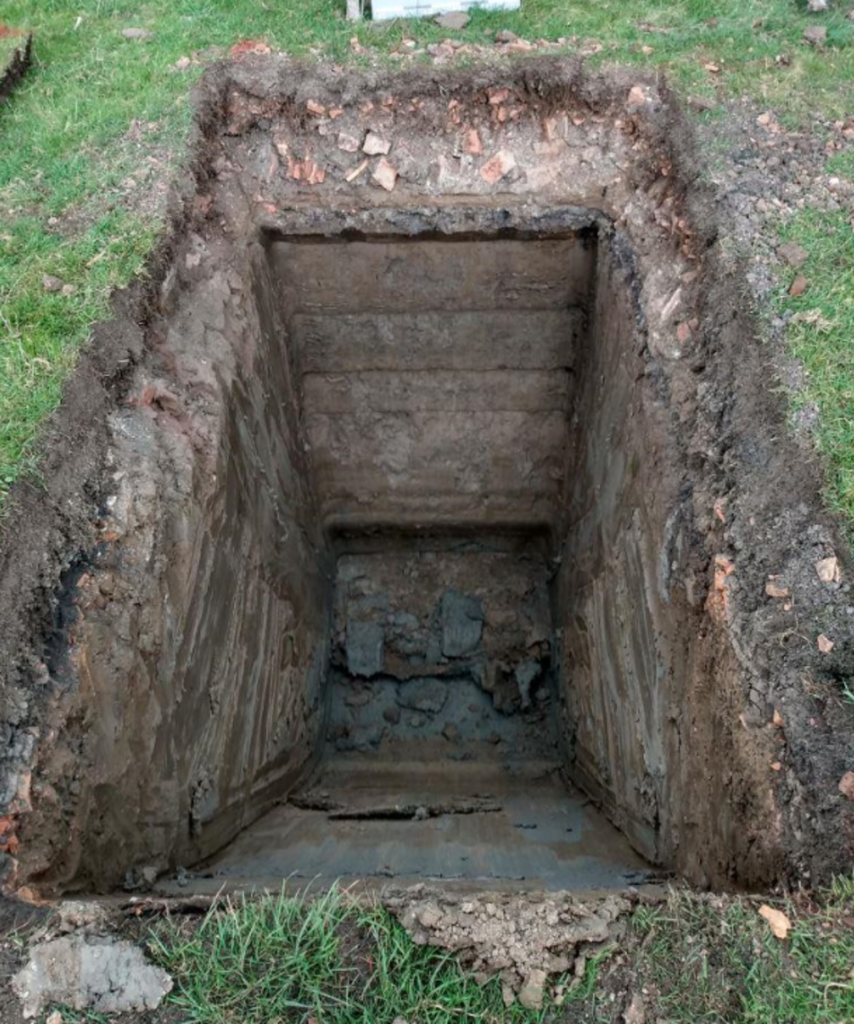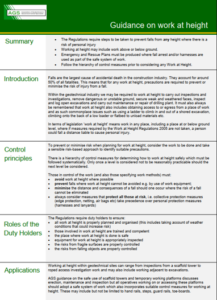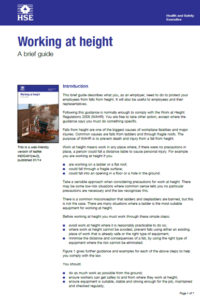
This is the second of a series of articles related to safety and trial pitting, following the June 2019 AGS Magazine article “Is trial pitting fit for purpose?”.
Imagine the situation: you are in a meeting at your office and your phone buzzes – a number you don’t recognise; it buzzes again, and you mute it. You carry on with your important meeting, when it buzzes with a text “URGENT – accident, call straightaway!”. You excuse yourself and call the unknown number. The voice says “I’m the JCB driver at … site; your Engineer has fallen into a trial pit; it’s quite deep and they’re hurt. What do we do?”, and then says “I’ve called the Fire Brigade, but they’re not here, and the pit sides are looking likely to collapse. There’s standing water and inflow at the base of the pit, and they might not be able to breathe soon!”
Perhaps reading this you are thinking to yourself that you wouldn’t get a call like that because you always have a 2 person team on site? Well maybe it’s one of the two calling you and you’ve still got a very difficult problem to address. Maybe you are thinking you won’t get that call because your company generic and site specific RAMS or Construction Phase Plan includes a detailed Emergency Rescue Plan for such a situation, and your staff have been trained on it, and the field team have been briefed on it, and there is equipment available. That would be good. Because you do have generic and site-specific rescue plans don’t you?
The AGS Safety guidance note “Work at Height”, which is based on the HSE document “Working at Height : a brief guide”, states “… this must include planning for emergencies and rescue, without resort to the emergency services in the first instance…”.
In Autumn 2019, the AGS Safety Working Group sent out questionnaires to AGS members, asking for their feedback on how they managed Work at Height when carrying out machine dug trial pitting activities, and particularly focused on logging activities close to the unprotected edge of a trial pit circa 2, 3, 4m+ deep. Whilst a specific question was not asked about rescue plans, not one of the respondents identified rescue plans as a part of their work at height / trial pitting arrangements. Because a specific “rescue” question was not asked in the questionnaire, it would be premature and unreasonable to deduce that none of the respondents employ rescue plans. But in collating and interpreting those survey responses, it started to concern me that no-one even mentioned it in their response.
The questionnaire and discussions within the AGS Safety Working Group over the past year, contributed to a paper presented at the AGS “Safety in Mind” conference in November 2019, entitled “How far is SFARP when working at Height during trial pitting”. Subsequent discussions following the presentation have concerned me that rescue plans for trial pitting, specifically rescuing a logging engineer who has fallen into a trial pit, do not appear to be as widely practiced as I might imagine.
There are all sorts of reasons why we carry out trial pitting, and why we have for many decades undertaken this by standing (for part of the operation at least) close to an unprotected edge of a pit several metres in depth. A discussion about those aspects is contained within the “Safety in Mind” conference presentation (which is available on the AGS website) and will be the subject of the next article in this series. There are discussions ongoing within the AGS Safety Working Group about Working at Height and trial pitting, and about new equipment coming into the industry which might be practicable, and which may further prevent a fall into a trial pit. However, until that becomes available, we should as an industry, and as employers and managers be thinking about rescue.
Rescue from a trial pit is not easy. You might have an extendable ladder within the boot of your car / van. But if the fallen person is injured, can they even climb a ladder? What if you descend the ladder, could you pick them up and carry them back up a ladder? Perhaps you could attach a rope to them and get the JCB to lift them out? Do you know how to attach a rope to an injured person, so that it will support them, and not lead to them slipping and being injured further? Perhaps if they were wearing a rescue harness then you could attach the rope to that, but that involves having a rope of sufficient strength available. Maybe you could wait for the fire brigade, but that presumes they can get there in time, are not dealing with other emergencies, and also that they can easily get to where you are trial pitting, which may not always be easy. And importantly, will they get there before the pit collapses, because if not you are dealing with removal of a body rather than rescue of an injured person. Maybe you think you could ride down on the JCB bucket and help the person into the bucket and lift them out. There certainly are products and equipment in the construction and utilities industries which might contribute to implantation of a pre-planned rescue. However, it is usually about this time in a discussion that someone will raise “Confined Space!”. Whether any individual trial pit is a confined space is dependent on actual site conditions, but a trial pit is certainly a potential confined space, not least if that groundwater inflow is causing a rise of water at the base of the pit, or if ground gas is present. And we probably all know the mantra about confined spaces – you don’t send another person in at risk to rescue because then we may have 2 people to rescue. What a conundrum! If it’s not easy to you, what kind of challenge does it pose to the JCB driver and your second young graduate engineer on site who are actually faced with it?
So, preparing for emergency rescue isn’t easy. It might involve equipment you don’t have; you would need to train your staff and brief others; you haven’t implemented it before and are not aware of others who have done so.
Maybe it is easier to just believe because it hasn’t happened to you before, it’s not too urgent. One thing the questionnaire responses identified, is that during hundreds of years of collective experience, none of the respondents or the author have experienced or known of a single case of a logging engineer / geologist falling into a trial pit. This is comforting to some extent. However, a fall into a trial pit would almost certainly lead to major injury, broken bones, back, neck etc. Or worse. I would suggest that as employers, managers and as an industry, our methods of work should allow human beings to make human mistakes (such as tripping or stumbling close to the edge perhaps) without having their life substantially affected forever as a result.
This article is not intended to be judgmental or critical. It is intended to raise, for discussion or action, an issue of concern, certainly to me at least. I have been involved in trial pitting for over 30 years and have derived great personal and project benefit from getting up close to the ground, and from the information that can be uniquely obtained from pits. I have no interest in “banning” trial pitting. The synthesis and collation of information on this subject over the past year however has prompted personal thoughts about whether we as an industry and employers are doing enough, particularly to seek other practicable technological solutions which allow us to continue to benefit from trial pitting.
Back to the initial telephone call. Let’s imagine that the Fire Brigade have got there, and fortunately, before the sides of the pit collapsed. Your staff member is out of the pit, but on their way to hospital with broken bones at least. You now have 3 telephone calls to make which will keep you from your important meeting – to your Managing Director, to the HSE/RIDDOR, the outcomes of which will no doubt lead to business loss and potential prosecution, and most importantly to the family of your injured member of staff.
I am sure that some readers will think this is “scaremongering”, and that people don’t fall down trial pits, as long as they are “competent” and follow sensible guidance and the (“perfect”) RAMS. Are you absolutely sure that you can rely on that; and what about UXO and Archaeology Watching Brief observers who also want to peer into the pit – are you sure? Do you want to make those telephone calls or speak to the HSE Inspector under caution?
Please have this discussion within your own projects and organisations. Download the AGS “Work at Height” guidance note and read it and disseminate it around your organisation to raise awareness. The AGS Safety Working Group are having this discussion and are establishing a Trial Pitting Sub-Group. Please let the AGS know your thoughts, views, experiences and ideas on rescue, particularly if you already implement a proven methodology for such a situation, which would benefit other AGS members from its dissemination.
The time to think about emergency rescue from a trial pit is NOT when you need it – it is long before. The person who needs to think about it is not your young logging engineer / geologist, but the employer and managers.
Article provided by Steve Everton, Director of Operations at Jacobs

